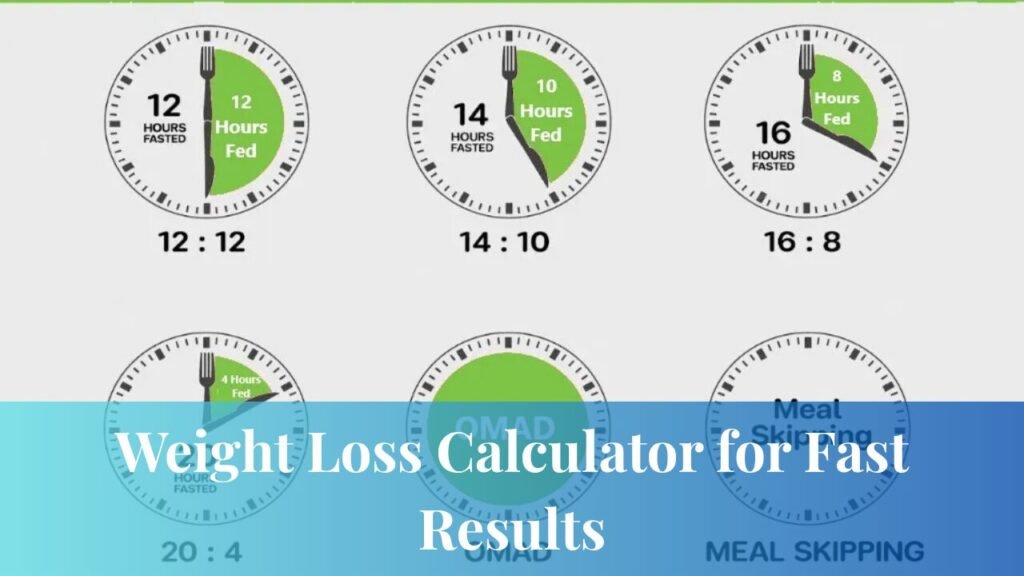Losing weight is not just about cutting calories—it’s about creating a sustainable, smart, and science-based plan. If you’ve struggled with weight management or hit a plateau in your journey, a weight loss calculator can be your personalized roadmap. This tool helps you understand how many calories you should consume daily based on your body composition, activity level, and weight goals.
By removing guesswork and giving structure, weight loss calculators play a pivotal role in helping users achieve consistent, healthy weight loss. Whether you’re just starting or want to get back on track, this guide is packed with practical insights grounded in science and trusted tools.
What Is a Weight Loss Calculator?
A weight loss calculator is a digital tool that estimates how many calories you need to consume daily to lose weight at a healthy rate. These calculators use scientific formulas to factor in personal data such as age, gender, height, current weight, activity level, and your weight loss goals with a set timeframe.
Using this information, the calculator determines your Basal Metabolic Rate (BMR) and Total Daily Energy Expenditure (TDEE). Based on these numbers, it provides a recommended calorie intake that creates a deficit, leading to fat loss.
Why Use a Weight Loss Calculator?
Without structured planning, most people either eat too little, which leads to energy crashes and muscle loss, or too much, which stalls progress. A weight loss calculator eliminates guesswork by giving you a personalized target based on scientific data.
It provides clarity and direction, making your weight loss journey more effective and less frustrating. It supports accountability, prevents under- or overeating, and helps you maintain muscle through better macro tracking.
How Weight Loss Calculators Work
Most calculators are built on two foundational elements: your Basal Metabolic Rate (BMR) and Total Daily Energy Expenditure (TDEE). These two figures determine how many calories your body burns daily and how much you should consume to stay in a healthy deficit.
Your BMR is the number of calories your body needs for basic functions like breathing and digestion. It can be calculated using the Mifflin-St Jeor or Harris-Benedict Equations. Your TDEE then adjusts BMR based on your activity level, and from there, a calorie deficit is applied to support fat loss.
Basal Metabolic Rate (BMR)
BMR represents the energy your body requires at rest. It’s the foundation of your calorie needs and can be estimated using equations like the Mifflin-St Jeor Equation. For example, the formula for men is: BMR = 10 x weight (kg) + 6.25 x height (cm) – 5 x age (y) + 5. For women, it’s the same but minus 161 instead of adding 5 at the end.
Knowing your BMR helps you understand the minimum calories your body needs before factoring in movement or exercise. This value ensures you’re not under-eating to the point of harming your metabolism.
Total Daily Energy Expenditure (TDEE)
TDEE is calculated by multiplying your BMR by an activity factor. This reflects how active you are throughout the day. For example, sedentary individuals multiply their BMR by 1.2, while very active individuals use a factor of 1.725.
This total helps determine how many calories you need to maintain your current weight. From here, creating a deficit of 500–1000 calories per day can result in safe weight loss of 1–2 pounds per week.
Caloric Deficit and Macro Breakdown
The key to weight loss is consistently eating fewer calories than your TDEE. A daily deficit helps the body burn stored fat, but it must be sustainable. Going too low can result in fatigue, muscle loss, and metabolic slowdowns.
Many calculators also offer macronutrient breakdowns—dividing your daily calories into proteins, fats, and carbs. A common split for weight loss is 40% carbs, 30% protein, and 30% fats. Protein is especially critical for preserving lean muscle during weight loss.
Key Features of Top Weight Loss Calculators
After analyzing platforms like boxingessential, MedIndia, and Calculators.org, it’s clear that great calculators offer more than basic calorie counting. Boxing Essential is beginner-friendly and provides both maintenance and target calorie ranges for users focused on general weight management.
MedIndia adds more precision with body fat percentage input and includes detailed fitness level options along with macro guidance. Calculators.org stands out with customizable timeframes, dual unit systems, and additional tools like BMI and macro calculators, making it useful for in-depth tracking.
How to Use a Weight Loss Calculator Effectively
To get the most accurate results, gather your data: your current weight, height, age, and typical activity level. Set a realistic goal aiming for 1 to 2 pounds of weight loss per week is sustainable and healthy.
Use a reliable calculator and input your information carefully. Review your daily calorie goal and start tracking your food intake using tools like MyFitnessPal, Cronometer, or Lose It!. As you lose weight or your activity level changes, recalculate every few weeks to stay on target.
Realistic Expectations
Weight loss is not a straight line. Some weeks you’ll see progress, and other weeks may show fluctuations due to factors like hormonal changes, water retention, or sleep quality. Your calculator is a great baseline tool, but you’ll need to stay flexible and adjust based on your body’s feedback.
Consistency over time will always yield results. Patience and perseverance, alongside regular recalibration, will help you stay motivated even when progress seems slow.
Case Study: Real-Life Application
Take Sarah, for example. She’s 34 years old, weighs 165 lbs, and is 5’6″ tall. Her goal was to lose 20 pounds over four months, and she maintained a moderate activity level with 3–4 workouts per week. Her BMR was 1450 kcal, and her TDEE was about 2250 kcal.
By consuming around 1750 kcal per day, she created a sustainable deficit. Over three months, Sarah lost 15 pounds, maintained muscle through resistance training, and noticed improvements in her mood, sleep, and energy levels. Her success came from consistent calculator use, eating high protein (~120g/day), and staying active.
Common Mistakes to Avoid
Using inaccurate inputs like underestimating activity or overestimating weight—can throw off your calculations. Avoid overly aggressive calorie deficits, which may lead to fatigue, binge eating, or muscle loss.
Neglecting protein intake is another common error. As you lose weight, failing to adjust your calorie needs or relying solely on tools without listening to your body can slow progress. The calculator is a guide, not a guarantee.
Frequently Asked Questions
How accurate is a weight loss calculator?
They are accurate within reasonable limits. They use standard formulas, but individual variations in metabolism, muscle mass, and hormones can affect outcomes.
Can I use a weight loss calculator while breastfeeding or pregnant?
No. These conditions require personalized medical advice to ensure both maternal and child health.
Do calculators work if I have hypothyroidism?
They can offer a starting point, but you should consult a healthcare provider. Hypothyroidism affects metabolism and may require tailored strategies.
Can I use the same calculator for gaining muscle?
Yes, many calculators have “weight gain” or “muscle building” modes. They will add a caloric surplus instead of a deficit.
What should I do if my progress stalls?
- Recalculate based on new weight
- Increase physical activity
- Ensure you’re tracking calories accurately
- Add refeed or maintenance days periodically
Tips for Long-Term Success
- Eat whole, nutrient-dense foods
- Strength train 2-4 times/week
- Prioritize protein (0.7g to 1g per lb of body weight)
- Get 7-9 hours of sleep per night
- Stay hydrated and limit processed sugars
- Use your calculator weekly or monthly to stay updated
Conclusion
A weight loss calculator is more than a digital gadget, it’s a strategic tool that empowers you to take control of your health. With personalized calorie targets and data-driven insight, it can help you reach your goals faster and more efficiently. Combine this with proper nutrition, regular physical activity, and a mindful approach to eating, and you have a proven formula for lasting results.
Start by using a reliable calculator from a trusted source. Stay consistent, make small adjustments as needed, and don’t underestimate the power of information. When you understand your body, you can transform it one calculated step at a time. Visit boxing Essential to explore more.




